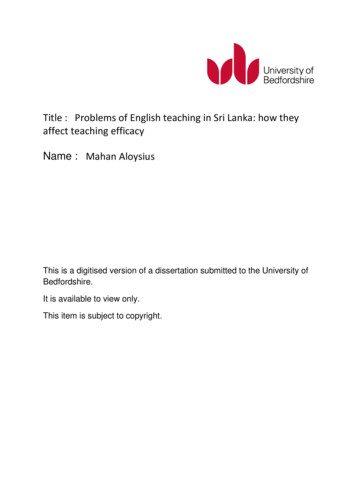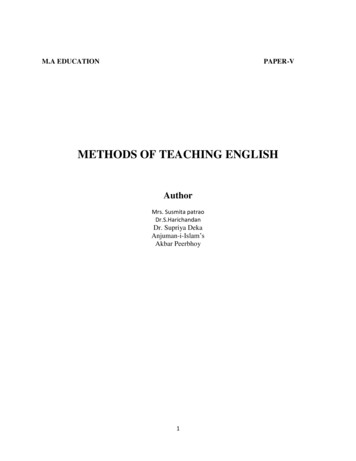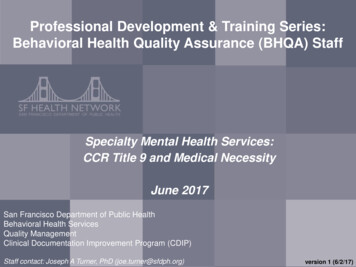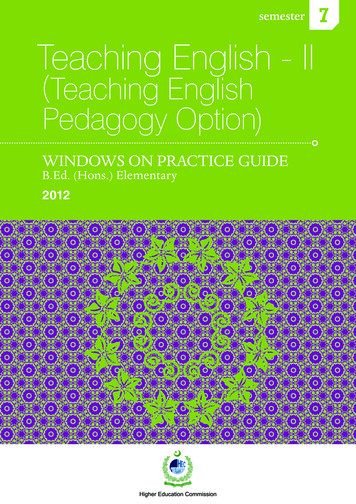
Transcription
Title : Problems of English teaching in Sri Lanka: how theyaffect teaching efficacyName : Mahan AloysiusThis is a digitised version of a dissertation submitted to the University ofBedfordshire.It is available to view only.This item is subject to copyright.
PROBLEMS OF ENGLISH TEACHING IN SRI LANKA:HOW THEY AFFECT TEACHING EFFICACYMahan AloysiusA thesis submitted to the University of Bedfordshire in partial fulfilment ofthe requirements for the degree of Doctor of PhilosophyJuly 2015i
ABSTRACTConcerned to comprehend the teaching efficacy of English teachers in Jaffna,Sri Lanka, this thesis investigated contentions by principals, retired teachers andresource personnel that Sri Lankan teachers’ lack of teaching effectiveness(teaching behaviours that influence student learning) accounted for students’low English attainment; and counter claims by English teachers that theirteaching efficacy (beliefs in their abilities to affect student learning) wasundermined by classroom and other-related problems.This mixed-method research comprised two stages. In a preliminary study, 298students and twenty-four teachers from twelve secondary schools participated in asurvey designed to understand challenges encountered in the teaching and learning ofEnglish. With a similar purpose, thirty-four English lessons involving 320 studentsand ten teachers were observed. Interviews concerning the aspects underpinningeffective English teaching were conducted with five principals, three Englishresource personnel and three retired teachers. In the main study, sixty-two teachersfrom thirty-five secondary schools were surveyed and twenty interviewed to identifyfactors which affected the teaching efficacy of English teachers. Participating schoolswere categorized vis-à-vis their students’ performance: low-performing and highperforming.Findings support English teachers’ views concerning their teaching efficacy.Teacher perception revealed associations between the lack of teaching efficacyof English teachers in low and high-performing schools, and teacherbackground/parental duties/self-development, classroom problems andinadequate educational resources. No explicit evidence was found that students’poor English attainment in low-performing schools was due to their teachers’lack of teaching effectiveness. Observations showed that students were deprivedof external resources which assisted students in high-performing schools tobecome proficient in English.New insights about Jaffna teachers’ efficacy indicate the need for a more contextspecific English language curriculum in Sri Lanka, informed by teachers’knowledge of their students’ English learning needs at a local level if teachingefficacy and English attainment are to be enhanced.ii
DECLARATIONI declare that this thesis is my own unaided work. It is being submitted for thedegree of Doctor of Philosophy at the University of Bedfordshire.It has not been submitted before for any degree or examination in any otherUniversity.Name of Candidate: Mahan AloysiusSignature:Date: July 2015iii
DEDICATIONThis work is dedicated To my beloved mother who continues to love me from ABOVE,To my loving aunts Anne and Rita who gave me their best till the end of their livesandTo my dearest cousin Jennet who completed her life journey as a very young andbudding teacher of English.iv
LIST OF CONTENTSAbstractiiDeclarationiiiDedicationivList of ContentsvReferencesxvAppendicesxvList of TablesxvList of DiagramsxviList of er 1:Background and Rationale of Study1Introduction1.1. The background of the study1.1.1. English language in Sri Lanka1.1.1.1 Introduction and teaching of English language1.1.1.2 Status of English in the state schools duringcolonial time1.1.1.3 Status of English after colonial time1.1.1.4 English education in the contemporary Sri Lanka1.2 The rationale of the study13331.31.2.1 The context1.2.1.1 The failure of English language teaching (ELT) inSri Lanka1.2.1.2 Problems related to the failure of ELT in Sri Lanka1.2.1.3 Criticism against teachers of EnglishUnderstanding the current study through attribution theory1.3.1 Meaning of the term attribution1.3.2 Attribution theory1.3.3 Fundamental Attribution Error and Self-Serving Biasv45677791112131316
1.41.51.61.71.81.91.3.4 Weiner’s attribution modelAim and focus of the studyImportance of the current studyEfficacy and EffectivenessResearch questionsParticipants and research instrumentsOrganisation of thesisChapter 2:18212223262727Education System and English Language Teaching(ELT) in Sri Lanka28Introduction2.1 General context of Sri Lanka2.1.1 Geography of Sri Lanka2.1.2 Ethnography of Sri Lanka2.1.2.1 Major ethnic groups2.1.2.2 Population2.1.2.3 Language and religion2.1.2.4 Location2.1.3 Post-colonial and contemporary Sri Lanka2.1.3.1 Post-colonial history2.1.3.2 Post-conflict Sri Lanka (from 2009 to date)2.2 General education in Sri Lanka2.2.1 Characteristics of the education system2.2.1.1 Unequal provision of education2.2.1.2 Politicised nature of education2.2.1.3 Impacts of above characteristics on the contextof the study2.2.2 Education network (current education system)2.2.2.1 School, student and teacher population in Sri Lanka2.2.2.2 Curriculum and learning strategies at secondaryeducation level2.2.2.3 Teaching strategies and regulations atsecondary school2.3 English Language teaching (ELT) in Sri Lanka2.3.1 ELT in the present education system of Sri Lanka2.3.1.1 Structure and Content of the ELT curriculum2.3.1.2 English learning strategies in secondary level2.3.1.3 Problems faced by teachers in aforementionedEnglish teaching approaches2.3.1.4 Learning materials and facilities in 44444495355
2.42.3.1.5 English learning opportunities outside classrooms2.3.1.6 English learning opportunities outside schools2.3.2 Teacher Education2.3.2.1 Recruitment and deployment of teachers2.3.2.2 Education and development2.3.2.3 Monitoring the impact of professional developmentat school levelChapter summaryChapter 3:56565757586262Background: Problems Associated to ELTin Sri Lanka64Introduction3.1 Issues related to students3.1.1 Lack of motivation of students3.1.2 Socio-economic status of parents3.1.3 Parental lack of understanding about the importanceof English3.1.4 Lack of English language exposure in social contexts3.1.5 Lack of access to differentiated learning materials3.1.6 Problems of teacher shortage3.2 Issues related to teaching and learning situations(classroom/school)3.2.1 Limited facilities for teaching and learning3.2.2 Overcrowded classrooms3.2.3 Problem of heterogeneity in student population3.3 Issues related to the curriculum3.3.1 The textbook3.3.1.1 Single textbook scheme3.3.1.2 Content of the textbook3.3.2 Language teaching approach3.3.2.1 Communicative Language Teaching (CLT)3.3.3 Challenges for CLT3.3.3.1 Lack of teacher student interaction and relationshipwith materials3.3.3.2 Teacher-centred and exam-oriented curriculum3.3.4 Problems related to the latest English teaching/learningstrategies3.4 Issues related to teachers3.4.1 Recruitment, education and deployment of teachers3.4.1.1 Recruitment and deployment of 77879808081
3.53.4.1.2 Education of teachers3.4.2 Lack of motivation of teachers3.4.3 Inefficiency of administration(school and zonal Department of Education)3.4.4 Low salary and lack of incentivesChapter summaryChapter 4:8285868787Literature Review on Effective Teaching of Englishand Teacher Efficacy89Introduction4.1 Effective Teaching of English4.1.1 Defining effective teaching4.1.1.1 Increasing students’ learning4.1.1.2 Ability to instruct heterogeneous students4.1.1.3 Planning and presenting the lesson4.1.1.4 Exercising various classroom practices4.1.1.5 ‘What’ and ‘How’ to teach4.1.2.6 Ability to connect teachers, students and lesson4.1.2 Distinctiveness of language teaching and teachers4.1.2.1 Unique professional situation of second languageteaching4.1.2.2 Distinctive characteristics of language teachers4.1.2.3 Context specific language teaching4.1.3 Characteristics of effective language teachers4.1.3.1 Literature based on the personal and professionalinsights of authors4.1.3.2 Research literature on the characteristics of effectivelanguage teachers4.1.4 Sri Lanka based literature on effective teaching of English4.1.4.1 Computer aided learning4.1.4.2 Material adaptation4.1.4.3 Encouraging students’ natural learning strategies4.2 Teacher efficacy4.2.1 Definitions of teacher efficacy4.2.2 Theoretical Perspectives4.2.2.1 The first conceptual strand4.2.2.2 A second conceptual strand4.2.2.3 Conceptual confusion of teacher efficacy4.2.2.4 Two classes of expectations4.2.2.5 Four sources of 6117118119119120120122123123124
4.2.2.6 Implication of sources of efficacy in Jaffna context4.2.2.7 Collective teacher efficacy4.2.2.8 Collective efficacy as a property of schools4.2.3 Teacher efficacy and positive teacher outcomes4.2.3.1 Setting high expectations for students and themselves4.24.41271281291301314.2.3.2 Teacher behaviours fostering student learning1314.2.3.3 Teacher decisions in favour of student learning needs1324.2.3.4 Responding to innovation and change1324.2.4 Teacher efficacy and its relationship with student motivationand achievement4.2.4.1 Teacher self-efficacy and students’ motivation4.2.4.2 Teacher self-efficacy and students’ achievement4.2.5 Teacher efficacy and teacher effectiveness4.2.5.1 Self-efficacy transfers skills to the classroom4.2.5.2 Self-efficacy facilitates classroom management4.2.5.3 Self-efficacy gives ability to respond in times of stress4.2.5.4 High self-efficacy in certain subjects produceshigh student achievements4.2.5.5 Self-efficacy has implications for overall schoolEffectivenessKey aspects of literature for the current studyChapter summaryChapter 5:Methodology and Data CollectionIntroduction5.1 Research method5.1.1 Mixed methods research5.1.1.1 Understanding of mixed methods research5.1.1.2 The reasons why mixed methods researchwas employed5.2 Research strategy5.2.1 Research question5.2.2 Purpose of a preliminary study5.2.3 Purpose of the main study5.2.4 Research goal and objectives5.2.5 Research procedure5.3 Overall processes of the current research5.3.1 Rationale for the use of research tools5.3.1.1 Questionnaires5.3.1.2 4144144145146149149149150151151152153153162
5.3.1.3 Lessons observation5.3.2 Participants and school classification5.3.3. The preliminary study5.3.3.1 Preliminary study research instruments5.3.3.2 Preliminary study sample5.3.3.3 Preliminary study data collection5.3.4 The main study5.3.4.1 Main study research instruments5.3.4.2 Main study sample5.3.4.3 Main study data collection5.3.5 Ethical consideration5.3.5.1 Approval of the research ethics scrutiny panel5.3.5.2 Approval to access schools and teachers5.2.5.3 Issues of consent5.3.5.4 Issues of confidentiality and anonymity5.3.6 Issues of reliability/validity/trustworthiness of data5.3.6.1 Reliability in questionnaires5.3.6.2 Reliability in lesson observations5.3.6.3 Reliability in interviews5.3.6.4 Insider researcher5.3.6.5 Reflexivity5.3.7 Data analysis and interpretation5.3.7.1 Quantitative data analysis5.3.7.2 Qualitative data analysis5.4 Chapter 00200201202204205207209209210215Chapter 6:216Data Presentation and Analysis of Preliminary StudyIntroductionPart One6.1 Students’ questionnaire6.1.1 Various opportunities that facilitate students’ learning ofEnglish6.1.2 Students’ English learning experience in the classroom6.1.3 Students’ expectations of their English teachers6.2 Lesson observations6.2.1 Physical and human settings6.2.2 Interactional and programme setting6.2.2.1 Teaching approach216217217Part Two6.3 Teachers’ questionnaire244244x217223226230230236236
6.46.56.66.3.1 Classroom problems6.3.1.1 The problems selected by teachers6.3.1.2 Problems mentioned by teachers but not includedin the list6.3.2 Socio-economic problems6.3.2.1 The problems selected by teachers6.3.2.2 Problems mentioned by teachers but not includedin the list6.3.3 Political problems6.3.3.1 The problems selected by teachers6.3.3.2 Problems mentioned by teachers but not includedin the list6.3.4 Final list of problems6.3.4.1 Classroom problems6.3.4.3 Socio-economic problems6.3.4.3 Political problemsInterviews with principals, resource personnel andretired teachers6.4.1 Aspects of English teaching efficacy6.4.1.1 Daily preparation of lessons6.4.1.2 Creative delivery of lessons6.4.1.3 Developing the subject matter and the pedagogicalknowledge6.4.1.4 Teaching what students actually need to learn6.4.1.5 Fulfilling the English language teaching regulationsproposed by Department of Education244245Discussion on the sub-research question6.5.1 Factors assumed to be advantageous to students inhigh-performing school6.5.2 Students’ learning experience in the classroom6.5.3 Concluding thoughts for the sub-research question ofthe preliminary studyDiscussion on operational criteria for main study6.6.1 Various problems affecting the English teaching efficacy6.6.2 Aspects of English teaching efficacy258Chapter 7:Main Study Data Analysis and DiscussionIntroductionPart One: main 254254255256258260262263264264266266268xi
7.17.27.37.47.57.6Problems with daily lesson preparation7.1.1 Various family commitments7.1.2 Teaching many classes in different gradesProblems in delivering creative lessons7.2.1 Creative teaching7.2.2 Lack of resources in the classroom7.2.3 Noise of learning environment7.2.4 Excessive number of students7.2.4.1 Affecting the smooth running of the lesson7.2.4.2 Affecting the distribution of learning aids7.2.4.3 Affecting the effectiveness of group tasks7.2.5 Problems related to textbookProblems in fulfilling the learning needs of students7.3.1 Fulfilling students’ needs and teaching curriculum7.3.1.1 Following the textbook and preparing studentsfor exam7.3.1.2 Students’ learning needs should have been addressedin the primary schoolProblem of teacher self-development7.4.1 Self-development in English language7.4.1.1 Lack of English language exposure in the classroom7.4.1.2 Lack of English language exposure in the schoolenvironment7.4.1.3 Lack of English language exposure in the socialcontexts7.4.2 Lack of English language exposure due to existingEnglish language curriculum7.4.3 Self-development in pedagogical knowledge of English7.4.3.1 Professional qualification of the sample7.4.3.2 Opportunities available for teacher self-development7.4.3.3 Factors that hindered pedagogical developmentProblems in co-operating with English language teaching (ELT)regulations7.5.1 Co-operation with ELT regulations7.5.1.1 Irrelevant and impractical ELT regulations7.5.1.2 Lack of intrinsic motivation of teachers7.5.2 Attitude of teachers towards fulfilling the ELT regulationsTeachers’ views on their own English teaching efficacy7.6.1 English teaching efficacy by teachers in low-performingschools7.6.1.1 Eliciting desire in students towards 315318318318
7.6.1.2 Teaching only what students could understandand grasp7.6.1.3 Taking bold decisions for the sake of students7.6.1.4 Co-operation of the educational authorities withteachers to be effective in teaching7.6.2 English teaching efficacy by teachers in high-performingschools7.6.2.1 Enhancing students’ communicative competence7.6.2.2 Making students autonomous in learningPart Two: sub-analysis7.7. Gender7.7.1 Daily lesson preparation and gender differences7.7.2 Conducting creative lesson and gender differences7.7.3 Fulfilling students’ learning needs and gender differences7.7.4 Self-development of teachers and gender differences7.7.5 English language teaching regulations and gender differences7.8 Teacher qualifications7.8.1 Daily lesson preparation and teacher qualification7.8.2 Conducting creative lesson and teacher qualification7.8.3 Fulfilling students’ learning needs and teacher qualification7.8.4 Self-development of teachers and teacher qualification7.8.5 English language teaching regulations andteacher qualification7.9 Length of time in profession and age group7.9.1 Daily lesson preparation7.9.2 Conducting creative lesson7.9.3 Fulfilling students’ learning needs7.9.4 Self-development of teachers7.9.5 Fulfilling English language teaching regulations7.10 Comparison of low and high-performing schools7.10.1 Workload of teachers7.10.2 Qualification of teachers7.10.3 Opportunities for professional development7.10.3.1 Opportunities for personal language development7.10.3.2 Opportunities for professional development7.10.4 Teaching and learning environment7.10.5 Teaching and learning materials7.10.6 Motivation for teachers7.11 Interplay of existing problems on teaching efficacy7.11.1 Interplay of problems in low and high-performing 1362363364366368370
7.11.2 Problems which made long standing impact onteaching efficacy7.12 Problems of English teaching efficacy according to Weiner’s model7.12.1 Attributions made by teachers7.12.1.1 Locus of control7.12.1.2 Stability7.12.1.3 Controllability7.12.2 Emotional responses of teachers7.12.2.1 Pride and self-esteem7.12.2.2 Relaxation or surprise7.12.2.3 Hopefulness and hopelessness7.12.2.4 Frustration7.12.2.5 Anger7.12.3 Behavioural changes of teachers7.13 Chapter hapter 8:390Conclusion and RecommendationsIntroduction8.1 Conclusions of the study8.1.1 Teacher related issues8.1.2 Various classroom problems8.1.3 Lack of opportunities for self-development of teachers8.1.3.1 Teacher qualification8.1.3.2 Length of time in profession and age group of teachers8.1.4 Inefficiency of educational authorities at various levels8.1.5 Teaching English effectively8.2 Recommendations8.2.1 Teacher education8.2.1.1 Professional qualification for teachers8.2.1.2 Continuous professional development (CPD) forTeachers8.2.1.3 School based teacher development (SBTD)8.2.1.4 Quality service from in-service advisors (ISAs)and other resource personnel8.2.2. Autonomy in education8.2.2.1 Learning materials for below average students8.2.2.2 English language teaching (ELT) programme forthe primary and secondary students8.2.2.3 Practicality and relevancy of English language 98398398399399400401401402403
8.38.48.58.68.2.3 Efficiency and co-operation of school administration8.2.3.1 Efficiency of school administration in mattersof teachers of English8.2.3.2 Optimum use of available resources in schools8.2.3.3 Fair teacher deployment and transfersContribution to knowledgeEvaluation of the studyRecommendations for future es419Appendices455Appendix-1Information on schools and the research context455Appendix-2Templates for data collection tools465Appendix-3Approval for the research496Appendix-4Main study questionnaire data499Appendix-5Main study interview data525List of TablesTable 1 Sri Lankan ethnic groups and religions31Table 2 Types of schools in Sri Lanka36Table 3 The research procedure152Table 3a Example of Likert scale survey155Table 4 Revised questions of student questionnaire171Table 5 Revised questions of teacher questionnaire173Table 6 Low-performing school student participants in questionnaire178Table 7 High-performing school student participants in questionnaire179Table 8 Low-performing school teacher participants in questionnaire179Table 9 High-performing school teacher participants in questionnaire179Table 10 Low-performing school classrooms for lesson observations180Table 11 High-performing school classrooms for lesson observations180Table 12 Low-performing school principals in interviews181xv
Table 13 High-performing school principals in interviews181Table 14 Summary of the sample of the preliminary study182Table 15 Example for question in main study teacher questionnaire186Table 16 Revised questions of teacher questionnaire188Table 17 Sample of questionnaire participants according to zones190Table 18 Sample of interview participants according to zones191Table 19 Summary of main study participants191Table 20 Gender of the questionnaire and interview participants192Table 21 Teaching institutions and teaching qualifications of thequestionnaire and interview participants193Table 22 Length of time in the profession of the questionnaire andinterview participants (low-performing schools)194Table 23 Length of time in the profession of the questionnaire andinterview participants (high-performing schools)194Table 24 Age group of the questionnaire and interview participants(low-performing schools)195Table 25 Age group of the questionnaire and interview participants(high-performing schools)195Table 26 Primary education of students217Table 27 Socio-economic background of parents218Table 28 Educational background of parents219Table 29 Learning English through English-Day competitions220Table 30 The most used strategy in the English lesson223Table 31 Physical and human settings of observed classrooms inlow-performing schools232Table 32 Physical and human settings of observed classrooms inhigh-performing schools234Table 33 Aspects of English teaching efficacyTable 34 Comparison of low and high-performing schools252356-357List of DiagramsDiagram 1 General features of lessons238xvi
List of FiguresFigure 1 Weiner’s original attribution model20Figure 2 Education Network of Sri Lanka40Figure 3 Stages of qualitative analysis211Figure 4 Visual process of qualitative analysis212Figure 5 Overall process of the current research214Figure 6 A line chart to show the difference in the number of studentsin low and high-performing schools who received variousopportunities for learning English222Figure 7 Students’ experience of learning English in classrooms224Figure 8 Different learning needs of students227Figure 9 Factors advantageous to students in high-performing schools259Figure 10 Teachers in low-performing schools on ‘Various FamilyCommitments'269Figure11 Teachers in high-performing schools on 'Various FamilyCommitments'269Figure 12 Teachers in low-performing schools on 'TeachingMany Classes'270Figure 13 Teachers in high-performing schools on 'TeachingMany Classes'270Figure 14 Teachers in low-performing schools on 'Lack of Resources’274Figure 15 Teachers in low-performing schools on 'Noise fromNeighbouring Classrooms'276Figure 16 Reasons selected by teachers in low-performing schools asproblems in fulfilling students' learning needsFigure 17 Reasons selected by teachers in low-performing schools toteach the curriculum onlyFigure 18 Reasons selected by teachers in high-performingschools to teach more than what is in the curriculum285286287Figure 19 Reasons selected by teachers in low-performing schools asdifficulties in self-developmentxvii294
Figure 20 Teachers in low-performing schools on 'Difficulty in gettingReading Materials on Pedagogy’303Figure 21 Teachers in high-performing schools on 'Working withExperienced Teacher’304Figure 22 Reasons selected by teachers in low-performing schools as difficultiesin co-operating with ELT regulations307xviii
ACKNOWLEDGEMENTSThis doctoral thesis would not have been possible without the immense support ofmy Director of Studies, Professor Uvanney Maylor. I am extremely thankful andindebted to her for sharing expertise, and the sincere and valuable guidance andencouragement extended to me.A sincere gratitude and appreciation is to my Co-Supervisor, Professor TonyGreen for his readiness and patience in helping me. Thanks to his insights whichgreatly assisted me in writing my thesis.I also wish to thank Professor Trevor Corner who initially guided me with hisvaluable thoughts in this research study.I would like to acknowledge the financial support provided by the University ofBedfordshire which was of great help in my study.I want to express my sincere gratitude to all respondents in Sri Lanka. A specialthank goes to my colleagues Rev. Frs. Charles Collins and Vimalasekaran(Vasanthan) who helped me a lot by distributing and collecting the teacherquestionnaires in Sri Lanka. I am also grateful to Rev. Sr. Sheila Moloney whoproofread my thesis and made it more presentable.Finally, my deepest gratitude goes to my loving parents and siblings whoencouraged and supported me both in my personal and academic life.xix
ABBREVIATIONSABOEActivity Based Oral EnglishCLTCommunicative Language TeachingCPDContinuous Professional DevelopmentDoEDepartment of EducationEL2English as a Second LanguageELSPEnglish as a Life-Skill ProgrammeELTEnglish Language TeachingGCE (A/L) or A/LGeneral Certificate of Education (Advanced Level)GCE (O/L) or O/LGeneral Certificate of Education (Ordinary Level)L2Second LanguageMoEMinistry of EducationNCOENational Colleges of EducationNIENational Institute of EducationSBASchool Based AssessmentTTCTeachers’ Training CollegeTESOLTeaching English to Speakers of Other Languagesxx
1.Background and Rationale of StudyIntroductionThe research problem investigated in this doctoral study was informed by theteaching experiences of the researcher in the context of Jaffna, one of the Northerndistricts of Sri Lanka. Whilst teaching English as a second language to students ina secondary school, he experienced various problems and challenges in theteaching and student learning of English such as lack of English resources in theclassroom, lack of motivation of students to learn English and lack of Englishlanguage exposure for students to practice what they learn in the language lessonare a few examples to mention. These problems and challenges on the one hand,prevented teachers from working effectively in the classroom and on the otherhand left more than half of the student populace without a pass in the OrdinaryLevel1 (O/L or G.C.E. O/L) English examination. For example, the pass rate ofstudents in the O/L English language in 2011 in one of the educational zones (see2.2.2 for explanation on educational zone) in the district of Jaffna was forty-threeper cent (Results Analysis – O/L, 2011). In addition, the researcher observed thatstudents in the Advanced Level2 (A/L or G.C.E. A/L) classes did not generally1. It is a General Certificate of Education (GCE) qualification in Sri Lanka,conducted by the Ministry of Education (MoE) for students at the end ofGrade Eleven (age sixteen). It is based on the British OrdinaryLevel qualification. Though a qualification in its own right, it is moreoften taken in prerequisite for the Advanced Level education.2. It is a General Certificate of Education (GCE) qualification in Sri Lanka,conducted by the MoE for students at the end of Grade Thirteen (agenineteen). It is similar to the British Advanced Level. The qualification isalso used as an entrance exam for Sri Lankan state universities.1
consider the English subject important as it was not compulsory at A/L andconsequently, the majority of the students left the school with a minimum level ofEnglish in spite of studying the language for more than ten years. The researcheralso considered that the challenges related to English Language Teaching (ELT)were hard to overcome or became more acute as the educational context of SriLanka was hugely affected by the prolonged internal political turmoil of thecountry. (All of the above are discussed in greater detail below).Furthermore, it was a recurring experience of the researcher that teachers ofEnglish frequently encountered criticisms from school principals, resourcepersonnel of ELT and retired teachers of English that the teaching of English bythe current teachers of English was not effective in order to improve students’knowledge of English; by effectiveness in English teaching they meant the dailypreparation of the lesson, delivering creative lessons to motivate students,fulfilling various learning needs of the students, self-development of the teachersand fulfilling the ELT regulations laid by the educational authorities (see chaptersix for more details). In many such situations teachers expressed frustration thattheir efforts to increase effectiveness in their teaching had been hindered andstifled by many classroom and other problems mentioned above.It is against this background that this doctoral research investigated howsecondary school (Grades Six to Eleven) teachers of English who teach English asa second language in state schools in Jaffna, Sri Lanka considered their Englishteaching efficacy had been influenced or affected by the classroom problems andsocio-economic and political challenges they encountered. The study sought tobring new insights to teaching efficacy within the context of ELT which is anunder-researched area.This opening chapter is divided into two parts. Part one presents the backgroundof the study and part two explains the rationale of the study. Part two alsointroduces the research problem through attribution theory which attempts tounderstand the attributions the teachers make to their failure in effective teachingof English. The aim, focus and importance of the current study, the research2
questions employed in this study and an overview of the chapters to follow arealso presented in part two.1.1 The background of the studySince the current study is related to teaching and learning of the English languagein Sri Lanka, the background of the study informs the reader with a general viewof the introduction, development and the current state of the English language inSri Lanka. This is essential for the reader to understand the rationale of the studywhich will be discussed in part two.1.1.1
2.1.2 Ethnography of Sri Lanka 29 2.1.2.1 Major ethnic groups 29 2.1.2.2 Population 30 2.1.2.3 Language and religion 30 2.1.2.4 Location 31 2.1.3 Post-colonial and contemporary Sri Lanka 31 2.1.3.1 Post-colonial history 31 2.1.3.2 Post-conflict Sri Lanka (from 2009 to date) 33 2.2 General education in Sri Lanka 33











